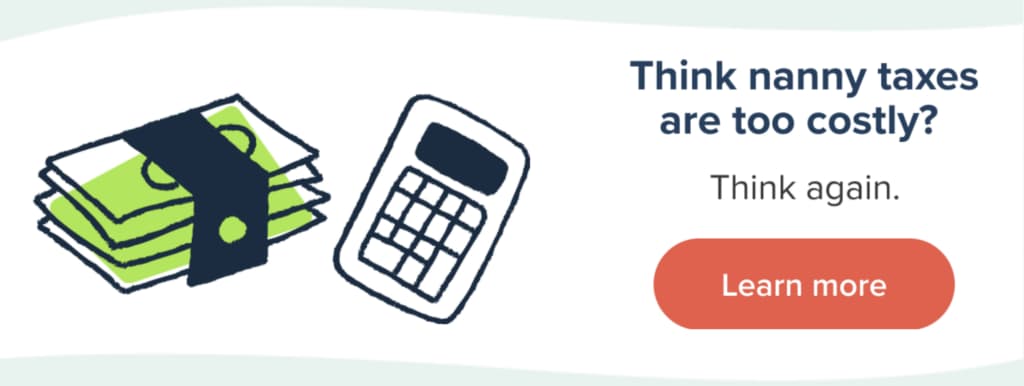Most people who hire a nanny or senior caregiver are not accountants or HR professionals. But with all the IRS regulations and labor laws you must follow when you take on a household employee, it may often feel like you are one. Without the proper knowledge and information, it can be easy for those without CPA or HR credentials to make mistakes.
Don’t worry, we’re here to help. Here are six of the most common household employment errors we see at HomePay, why they’re wrong and how you can avoid them.
Mistake #1: Giving your nanny the wrong tax form
“One of the biggest myths is that you can 1099 your nanny,” says lawyer Lisa Pierson Weinberger. “If you issue a 1099, you are not in compliance with the law.” This is because Form 1099 is used for independent contractors, not for employees. Independent contractors are self-employed and control the aspects of the job they’re performing.
According to IRS Publication 926, caregivers like nannies are considered household employees. Your nanny is your employee because they come to your house during the days and hours you require them to and follow the rules you set for how your kids should be cared for. As an employer, you are required to give your nanny a W-2 to file their taxes, and you must file and pay taxes in accordance with the deadlines set by the IRS and state tax agencies.
Read more: Is your caregiver an employee or an independent contractor?
Mistake #2: Not paying overtime
How much does your caregiver work? Household employees are generally considered non-exempt workers, which means federal law entitles them to time-and-a-half for all hours over 40 in a 7-day workweek. And it doesn’t matter whether you consider your employee full time or part time.
But what about if you have a live-in caregiver? Most states don’t require overtime for live-ins, but a few states (California, Hawaii, Maine, Maryland, Massachusetts, Minnesota, Nevada, New Jersey, New York and Oregon) have more specific laws.
Learn more about why nannies get overtime and how to handle it.
Mistake #3: Paying your caregiver through your company’s payroll
Whether you’re an entrepreneur or own a company, an in-home caregiver is considered your personal employee, not your company’s. Yes, it may seem easier to put them on your business’ payroll, but it’s not allowed by the IRS, which doesn’t consider nannies and other household employees as direct contributors to your business. Therefore, these wages can’t be reported on a business tax return — and any tax deductions taken on these wages are illegal.
You need to keep the two payrolls separate. Instead of paying your caregiver via company payroll and taking a business tax deduction, you should pay them through your personal bank account and take a personal tax deduction on your federal income tax return.
Mistake #4: Waiting until April 15th to handle your nanny taxes
Because most families are used to filing their personal income taxes once per year, they think they can handle household employment taxes the same way. Unfortunately, these taxes work differently. They’re filed year-round — generally four times per year with the IRS and quarterly in most states. Follow this nanny tax timeline to keep it all straight and read more about how to pay nanny taxes yourself.
Mistake #5: Thinking nanny taxes only apply to families with nannies
The term “nanny taxes” became popular when Zoe Baird, a nominee for Attorney General in the early 1990s, was found to be paying her nanny under the table. However, if you pay anyone $2,700 or more in a calendar year to come to your house to do a specific job at a specific time and follow your rules, the so-called “nanny tax” likely applies to them as well. Senior caregivers, personal assistants, full-time housekeepers and estate managers all fall under this umbrella because you’ve established a household employer/employee relationship.
Read more about your responsibilities when hiring a household employee.
Mistake #6: Forgetting to capitalize on tax breaks
When you pay your caregiver on the books, it opens you up to tax breaks. If you or your spouse has access to a dependent care flexible spending account through work, you can pay for up to $5,000 of care-related costs pre-tax. The savings can add up to thousands of dollars. And you might also be eligible for the child care tax credit, which can give you up to $1,200 in tax savings in 2024.
“Using one or both of these breaks can significantly reduce the cost of being a household employer,” says Tom Breedlove, Sr. Director at Care HomePay. “Some families even save money by paying legally because their savings outweigh their tax liability.”
Next Steps:
- See how nanny taxes work in your state.
- Learn how much to pay a nanny in your area.
- Read about how your family can afford nanny taxes.
* The information contained in this article is general in nature, may not be applicable to your specific circumstances, and is not intended to be a substitute for or relied upon as personalized tax or legal advice.


